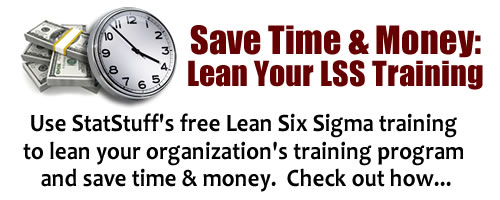Dictionary of Lean Six Sigma Tools/Concepts
There are 8 entries in this dictionary.| Term | Definition |
|---|---|
| Lean Adapted to DMAIC Flow | A method of adapting Lean tools and concepts to the Six Sigma methodology of DMAIC. Lean is more of a philosophy and doesn't have a standard methodology like Six Sigma. So this borrows the DMAIC method of resolving a problem but rather than using Six Sigma's goal of making a more effective output, it uses the Lean tools/concepts with a goal of making a more efficient process. |
| Lean Philosophy | A mindset, belief, or culture toward continuously improving every aspect of a process or operation to make it more efficient (i.e., improving time, effort, cost or flow). Lean is considered a philosophy as opposed to a methodology because it's not based on a set of sequential steps, but is a way of thinking that focuses on identifying and eliminating waste in a process. A common mindset is that no process is 100% perfect, so there is always opportunity for improvement even at the seemingly small, insignificant level. |
| Lean Workout | Also known as a Kaizen event, it is an extended meeting (often lasting 1 to 5 days) that focuses on improving processes using Lean tools and concepts. It usually includes all stakeholders that are critical to the process being improved. The goal of the workout is to design an improved process with either it fully implemented or at least a defined implementation plan. |
| Logistic Regression | A statistical model that is used like a regression analysis, but is based on or includes discrete (a.k.a. attribute or categorical) data. As a regression analysis, it can be used to assess how much certain factors influence the discrete output value, or to help predict future discrete output values. Three common types of logistic regression models can be used depending on the type of output discrete data being used: 1) a Binary Logistic Regression (BLR) is used when the discrete data are binary (i.e., having only two possible values like Yes/No, True/False, etc.); 2) an Ordinal Logistic Regression (OLR) is used when the discrete data are ordinal in nature (i.e., having more than two possible values that fall in an order or in scale with each other, like 1st, 2nd, 3rd, etc.; or Worst, Average, Best; or a Likert scale such as Very Dissatisfied, Dissatisfied, Satisfied, Very Dissatisfied); 3) a Nominal Logistic Regression (NLR) is used when the discrete data are nominal in nature (i.e., having more than two possible values that aren't in order with each other, like colors, locations, characteristics, etc.). |
| Long Term Data | Data that generally covers a full range of time, is collected across all sub-groups, and often includes both common and special causes. Compare with short term data. |
| Lower Control Limit (LCL) | |
| Lower Specification Limit (LSL) | A statistical reference for the lower level target of a continuous data point defined by the customer such that anything beneath it is considered a defect or not meeting the customer's needs (a.k.a. voice of customer or VOC). It essentially represents the minimum measurable point of tolerance for the customer. This is contrasted with the upper specification limit (USL). |
| LSS (Lean Six Sigma) | It generally refers to the blending of both Lean and Six Sigma into a single approach toward resolving business problems. Lean and Six Sigma can be thought of as two sides of the same coin; that is, they have the same general purpose of improving business operations but approach it from different, yet complementary perspectives. |


